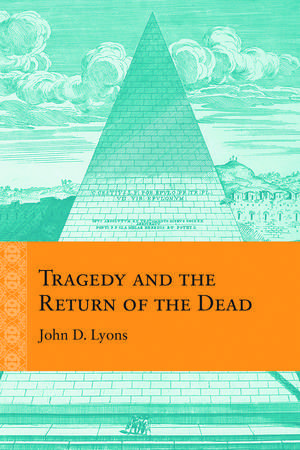Tragedy and the Return of the Dead: Rethinking the Early Modern
Autor John D Lyonsen Limba Engleză Paperback – 14 mai 2018
Early modernity rediscovered tragedy in the dramas and the theoretical writings of the ancient Greeks and Romans. Attempting to make new tragic fictions, writers like Shakespeare, Webster, Hardy, Corneille, and Racine created a dramatic form that would probably have been unrecognizable to the ancient Athenians. Tragedy and the Return of the Dead recovers a model of the tragic that fits ancient tragedies, early modern tragedies, as well as contemporary narratives and films no longer called “tragic” but which perpetuate the same elements.
Authoritative, wide-ranging, and thought provoking, Tragedy and the Return of the Dead uncovers a set of interlocking plots of family violence that stretch from Greek antiquity up to the popular culture of today. Casting aside the elite, idealist view that tragedy manifests the conflict between two equal goods or the human struggle against the divine, John D. Lyons looks closely at tragedy’s staging of gory and painful deaths, ignominious burials, and the haunting return of ghosts. Through this adjusted lens Le Cid, Hamlet, Frankenstein, The Spanish Tragedy, Romeo and Juliet, Phèdre, Macbeth, and other early modern works appear in a striking new light. These works are at the center of a panorama that stretches from Aeschylus’s Agamemnon to Hitchcock’s Psycho and are placed against the background of the Gothic novel, Freud’s “uncanny,” and Burke’s “sublime.”
Lyons demonstrates how tragedy under other names, such as “Gothic fiction” and “thrillers,” is far from dead and continues as a vital part of popular culture.
Authoritative, wide-ranging, and thought provoking, Tragedy and the Return of the Dead uncovers a set of interlocking plots of family violence that stretch from Greek antiquity up to the popular culture of today. Casting aside the elite, idealist view that tragedy manifests the conflict between two equal goods or the human struggle against the divine, John D. Lyons looks closely at tragedy’s staging of gory and painful deaths, ignominious burials, and the haunting return of ghosts. Through this adjusted lens Le Cid, Hamlet, Frankenstein, The Spanish Tragedy, Romeo and Juliet, Phèdre, Macbeth, and other early modern works appear in a striking new light. These works are at the center of a panorama that stretches from Aeschylus’s Agamemnon to Hitchcock’s Psycho and are placed against the background of the Gothic novel, Freud’s “uncanny,” and Burke’s “sublime.”
Lyons demonstrates how tragedy under other names, such as “Gothic fiction” and “thrillers,” is far from dead and continues as a vital part of popular culture.
Preț: 347.81 lei
Nou
Puncte Express: 522
Preț estimativ în valută:
66.55€ • 69.86$ • 55.24£
66.55€ • 69.86$ • 55.24£
Carte indisponibilă temporar
Doresc să fiu notificat când acest titlu va fi disponibil:
Se trimite...
Preluare comenzi: 021 569.72.76
Specificații
ISBN-13: 9780810137042
ISBN-10: 0810137046
Pagini: 288
Ilustrații: 10 b-w images running in text
Dimensiuni: 152 x 229 x 18 mm
Greutate: 0.36 kg
Editura: Northwestern University Press
Colecția Northwestern University Press
Seria Rethinking the Early Modern
ISBN-10: 0810137046
Pagini: 288
Ilustrații: 10 b-w images running in text
Dimensiuni: 152 x 229 x 18 mm
Greutate: 0.36 kg
Editura: Northwestern University Press
Colecția Northwestern University Press
Seria Rethinking the Early Modern
Notă biografică
JOHN D. LYONS is Commonwealth Professor of French at the University of Virginia.
Cuprins
Preface
Acknowledgments
Introduction
Chapter I: Home and hearth
Chapter II: Burial and the care of the dead
Chapter III: Specters
Chapter IV: The aesthetics of fear
Conclusion: What's in a word?
Notes
Acknowledgments
Introduction
Chapter I: Home and hearth
Chapter II: Burial and the care of the dead
Chapter III: Specters
Chapter IV: The aesthetics of fear
Conclusion: What's in a word?
Notes
Descriere
In Tragedy and the Return of the Dead, John D. Lyons surveys a wealth of literary works from a wide range of periods and cultures to show how aspects of ancient and early modern tragedy continue to animate and inform popular culture.














